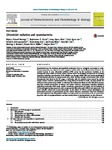Ultraviolet radiation and cyanobacteria.
| dc.contributor.author | Rastogi, RP | en |
| dc.contributor.author | Sinha, RP | en |
| dc.contributor.author | Moh, SH | en |
| dc.contributor.author | Lee, TK | en |
| dc.contributor.author | Kottuparambil, S | en |
| dc.contributor.author | Kim, Y-J | en |
| dc.contributor.author | Rhee, J-S | en |
| dc.contributor.author | Choi, E-M | en |
| dc.contributor.author | Brown, MT | en |
| dc.contributor.author | Häder, D-P | en |
| dc.contributor.author | Han, T | en |
| dc.date.accessioned | 2015-12-10T14:03:54Z | |
| dc.date.available | 2015-12-10T14:03:54Z | |
| dc.date.issued | 2014-12 | en |
| dc.identifier.uri | http://hdl.handle.net/10026.1/3919 | |
| dc.description.abstract |
Cyanobacteria are the dominant photosynthetic prokaryotes from an ecological, economical, or evolutionary perspective, and depend on solar energy to conduct their normal life processes. However, the marked increase in solar ultraviolet radiation (UVR) caused by the continuous depletion of the stratospheric ozone shield has fueled serious concerns about the ecological consequences for all living organisms, including cyanobacteria. UV-B radiation can damage cellular DNA and several physiological and biochemical processes in cyanobacterial cells, either directly, through its interaction with certain biomolecules that absorb in the UV range, or indirectly, with the oxidative stress exerted by reactive oxygen species. However, cyanobacteria have a long history of survival on Earth, and they predate the existence of the present ozone shield. To withstand the detrimental effects of solar UVR, these prokaryotes have evolved several lines of defense and various tolerance mechanisms, including avoidance, antioxidant production, DNA repair, protein resynthesis, programmed cell death, and the synthesis of UV-absorbing/screening compounds, such as mycosporine-like amino acids (MAAs) and scytonemin. This study critically reviews the current information on the effects of UVR on several physiological and biochemical processes of cyanobacteria and the various tolerance mechanisms they have developed. Genomic insights into the biosynthesis of MAAs and scytonemin and recent advances in our understanding of the roles of exopolysaccharides and heat shock proteins in photoprotection are also discussed. | en |
| dc.format.extent | 154 - 169 | en |
| dc.language | eng | en |
| dc.language.iso | eng | en |
| dc.subject | Antioxidants | en |
| dc.subject | Bacterial Proteins | en |
| dc.subject | Cyanobacteria | en |
| dc.subject | Cyclohexanones | en |
| dc.subject | DNA Damage | en |
| dc.subject | Heat-Shock Proteins | en |
| dc.subject | Indoles | en |
| dc.subject | Phenols | en |
| dc.subject | Polysaccharides, Bacterial | en |
| dc.subject | Stress, Physiological | en |
| dc.subject | Ultraviolet Rays | en |
| dc.title | Ultraviolet radiation and cyanobacteria. | en |
| dc.type | Journal Article | |
| plymouth.author-url | https://www.ncbi.nlm.nih.gov/pubmed/25463663 | en |
| plymouth.volume | 141 | en |
| plymouth.publication-status | Published | en |
| plymouth.journal | J Photochem Photobiol B | en |
| dc.identifier.doi | 10.1016/j.jphotobiol.2014.09.020 | en |
| plymouth.organisational-group | /Plymouth | |
| plymouth.organisational-group | /Plymouth/Faculty of Science and Engineering | |
| plymouth.organisational-group | /Plymouth/REF 2021 Researchers by UoA | |
| plymouth.organisational-group | /Plymouth/REF 2021 Researchers by UoA/UoA06 Agriculture, Veterinary and Food Science | |
| plymouth.organisational-group | /Plymouth/Research Groups | |
| plymouth.organisational-group | /Plymouth/Research Groups/Marine Institute | |
| dc.publisher.place | Switzerland | en |
| dcterms.dateAccepted | 2014-09-25 | en |
| dc.identifier.eissn | 1873-2682 | en |
| dc.rights.embargoperiod | 12 months | en |
| rioxxterms.versionofrecord | 10.1016/j.jphotobiol.2014.09.020 | en |
| rioxxterms.licenseref.uri | http://www.rioxx.net/licenses/under-embargo-all-rights-reserved | en |
| rioxxterms.licenseref.startdate | 2014-12 | en |
| rioxxterms.type | Journal Article/Review | en |


